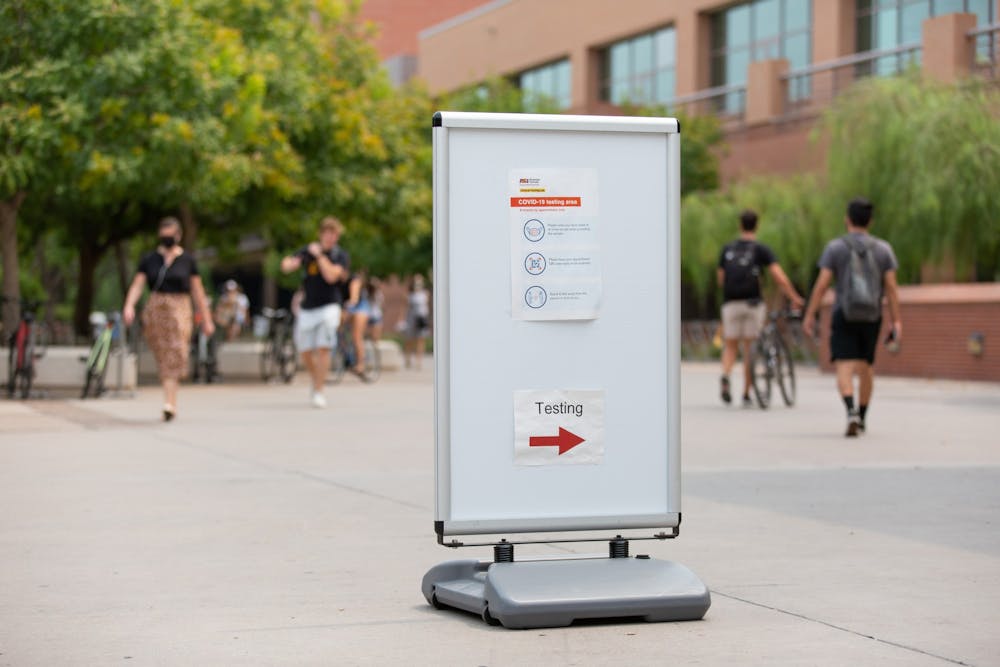There are 775 total COVID-19 positives among students, 323 of them on the Tempe campus and 428 of them off campus, according to a University update.
There are 24 cases split between the Downtown Phoenix and West campuses, and there are zero cases on the Polytechnic campus. Faculty positives remain at 28 cases.
The number of total cases in the ASU community is now 803, an increase of 323 since last Friday's late-night update.
Since Aug. 1, results from 40,402 tests have been collected, yielding a percent positivity rate of roughly 1.98% among the total University population. The University is reporting a percent confirmed positive among employees and the student body of 0.2% and 1.04%, respectively.
The University is reporting the percent of confirmed positives among specific populations. This calculation uses the number of students or faculty as the denominator, while the percent positivity rate calculation uses the total number of tests as the denominator.
The percent positive is a more accurate number for determining transmission rates and the effectiveness of testing.
"We are dealing with a heck of a thing – a heck of a thing called COVID," President Michael Crow said in a University Senate meeting Monday.
The update also listed four different housing modes of operation. The University has entered mode three, which allows the University to "de-densify higher risk living configurations" on-campus, increase security, restrict external visitors and only allow "one guest per room from within the same residence hall at any given time."
Repeat offenders of violations will be subject to housing removal.
Housing mode four would be the next potential phase if and when needed. It would only allow students with no other living options to request an exemption to live in residence halls.
Housing mode five would close residence halls completely. Thresholds for mode changes were not published with the update.
Monday's update is the third of the semester after the University said this summer it would not publish campus-wide data on cases within the ASU community.
The update includes an explanation of the University's learning modes of operation. Classes are currently conducted in mode two. The next two modes would lead to more courses being offered solely through iCourses and ASU Sync, with the final mode requiring all classes to be delivered virtually.
Classes are still to be held in person and precautions are still the same around campus: Masks are required in and outside of buildings, no guests in residence halls, completion of daily health checks are required and students must adhere to the University's guidelines on social distancing.
Outside of the updates, some students living in residence halls only learned about positive COVID-19 cases from social media and rumors among peers.
Despite the updates from the University, students are still relying on each other to find out where the cases are with ASU not disclosing precise locations of cases outside of the campus location, citing privacy reasons.
For Rachel Williams, a freshman majoring in political science, it has led to small changes in her daily campus routine: Taking the stairs instead of the elevator, using hand sanitizer every time she goes out and asking new people she meets “the broad questions” of where they have been and who else they have met.
“You kind of have to assume the worst,” when you meet new people, Williams said.
Steffen Eikenberry, a postdoctoral assistant with research expertise in medicine and mathematics, recently published a mathematical analysis of the data publicly available about COVID-19 at ASU.
The research is not completely accurate due to a lack of specific data and it has not been peer-reviewed. Eikenberry stressed the lack of data was an issue of transparency.
However, he asserts that ASU's data presented prior to Monday's update has been misleading and even suggests a spreading epidemic within campus.
"Rather than being under control, all data available to the public indicates instead an epidemic that is out of control and spreading rapidly," Eikenberry wrote.
Eikenberry's estimates the Rt, the rate of infection, is higher within the ASU community than in the state of Arizona itself.
Reach the reporter at pjhanse1@asu.edu and follow @piperjhansen on Twitter.
Like The State Press on Facebook and follow @statepress on Twitter.

Piper Hansen is the digital editor-in-chief at The State Press, overseeing all digital content. Joining SP in Spring 2020, she has covered student government, housing and COVID-19. She has previously written about state politics for The Arizona Republic and the Arizona Capitol Times and covers social justice for Cronkite News.




